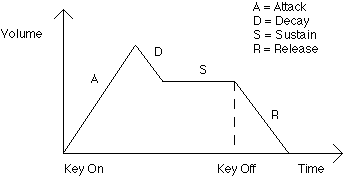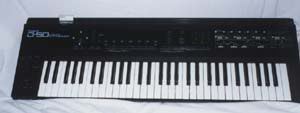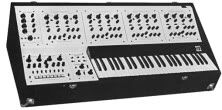
Joined: 27 Jun 2006
Posts: 92
Location: Kuala Lumpur / Johor Bahru
|
I've found this article very useful 4 a better understandin of synthesizer...esp 4 a beginner like me...
Check These Out To Better Understand Synthesizers - by Micheal Droste
General Information - Synthesizers work in generally the same manner. They all contain some type of sound wave which can be edited by an envelope. The envelope is how the sound develops and is changed over the note's life. It would be a very boring sound, if when you push the key down until you released it , the sound remained unchanged. The name for the different stages that a sound goes through is called ADSR = Attack, Decay, Sustain, Release. Think for a second at what happens when you press the key on a synthesizer.
1. First, there is the attack of the sound, the very first thing you hear.
2. Secondly, you have the decay of the sound, this is what you hear right after the attack.
3. Thirdly, you have the sustain, this is what you hear for the duration of the sound.
4. Finally, you have the release, this is what happens when you lift your finger off the key.

All of the four stages can be controlled or modified in synthesizers. For example, you might want the attack of a violin sound to be slow and gradual for use in a movie. Simply go into the synthesizers editing page on attacks, and extend the attack to give you the desired effect. Perhaps, with the same violin sound, you want the release at the end to be gradual. Again, go into the release editing page of the synthesizer and change that parameter. There are a host of other editing features that you can change including: effects(echo, delay, reverb) filters, volumes, multiple layers, MIDI setup, etc.. There are also synthesizer modules that are the brains of the synthesizer without the keys. These take up less space and offer the exact same features of the keyboard version. One can play these modules through a MIDI controller or another synthesizer. One only needs one keyboard then the other synthesizers/samplers could be in module form. There are numerous software companies that make editors/librarians for all synthesizers. These make editing synthesizers easier as the large computer monitor can display more information on one screen. The following are a list of synthesizer companies: Waldorf, Yamaha, Roland, Alesis, General Music, Peavey, Korg, E-mu, Kurzweil, Ensoniq and Oberheim

The Legendary Yamaha DX7IIFD
Frequency Modulation Synthesis - Commonly called FM synthesis began in 1983 with the introduction of the Yamaha synthesizers. The first type of FM synthesis involved taking a sine wave, and modulating it with other sine waves to create a more complex wave form. The next generation of FM synthesis allowed one to select eight different complex wave forms and modulate it with another complex wave form. This kind of synthesis was found on units such as the TX81Z, and V50 to name a few. This type of synthesis is often called selectable wave synthesis. The third type of FM synthesis is called AFM (Advanced Frequency Modulation) Synthesis. AFM allows one to take a sample from the internal of the keyboard, input it into the FM formula to create a new sound. This FM also contains sine waves and selectable waves. AFM synthesis is found on the following keyboards and modules SY55, SY77, TG77. Today, you can take in samples of any sound through the MIDI sample dump standard, and then put them through different envelopes and filters!

Roland D50
Linear Arithmatic Synthesis - LA synthesis is commonly found in Roland Synthesizers. LA synthesis involves taking a high quality sampled attack, and combining it with a synthesized ending. The attacks are short, and can be layered. The synthesizer portion of the sound can be changed using envelope generators and filters. The actual samples are called PCM or Pulse Code Modulation. This type of synthesis is very popular and used by many musicians.

The Kawai K5 Rackmount Synthesizer
Additive Synthesis - This is a very powerful type of synthesis, that involves the combination of the audio outputs of two sine waves. In the case of FM synthesis this was done mathematically. In FM, the sine waves were converted into numbers, then combined numerically and then changed back into sound. In additive synthesis, the actual electric current of the sine waves are combined. The only consumer keyboard that contained additive synthesis was the Kawai K5 synthesizer. One feature of additive synthesis was the ability to go into the sine wave and increase or decrease the strength of any combination of the overtone series. The only problem was that one needed to know what the wave form looked like to change it. Unless one had seen that particular wave and knew it's characteristics, one was only guessing or blindly experimenting with the editing features.

The Korg M1 Synthesizer
Wave Synthesis - This is currently the most popular type of synthesis used in keyboards today. Basic sound waves, such as piano, strings and brass are digitized. Once these wave forms are digitized we can then layer them together and affect them with envelope generators and filters. Kurzweil, Ensoniq, Yamaha and Korg are all using this type of synthesis in their keyboards. Many keyboards contain hundreds of basic waves that are able to be combined and used for creating more complex sounds.

Analog Synthesis - This was the first synthesis available to the consumer. Analog works by taking electric current and changing it into sound by using voltage control oscillators (VCO). This synthesis was very unstable, as the wall current changed, so did the tuning of the keyboard. The Mini - Moog had three oscillators, one could layer three electronic currents, each with it's own envelope, and a filter over the entire sound. The Mini - Moog was a monophonic synthesizer that could only play one note at a time. Polyphonic synthesizers are those that can play many notes at the same time. Today's analog synthesizers use digitally controlled oscillators (DCO), and tuning is no longer a problem.
Mr. Droste was a participant in the Fermilab LInC program sponsored by Fermi National Accelerator Laboratory, Friends of Fermilab and the Illinois State Board of Education.
_________________
++Sta Painter++ |
|

